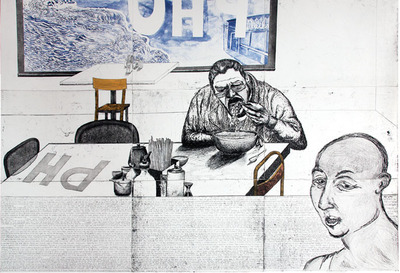DANIEL HEYMAN: Summer Fall Winter Spring
Cade Tompkins Projects • Providence, RI • www.cadetompkins.com • September 8–October 27, 2012

Daniel Heyman, Fall: Artist Eats Pho, 2011
After five years of focusing his attention on the human rights violations of the Iraq War, telling of the atrocities committed through intimate portraits of innocent Iraqi prisoners of war, painter and printmaker Daniel Heyman needed a break.
It arrived in the form of an invitation to work on a self-portrait. The resulting print, Summer: Artist Sleeps tiled together from eight prints, shows Heyman asleep in a hammock strung between rustic tree trunks. Cocooned, he is at peace, catching a break from work and the emotional strain of documenting the victims and telling of their harrowing experiences during the war.
But the human rights activist that defines this artist does not rest from his pursuit for too long: Summer: Artist Sleeps inspired a series of four self-portraits of the artist who has spent so much time depicting others. And already in Fall: Artist Eats Pho, ostensibly depicting the artist eating a Vietnamese dish, he is back documenting injustice. Etched across the bottom of the image, in similar fashion as in the earlier portraits of prisoners, is the head of Hung Nguyen, the owner of the restaurant, accompanied by text narrating his daunting escape from Vietnam.
Tiled together from nine plates, Winter: Artist Engages is the largest and most ambitious of the four works. Printed on plaster, with the material representing the season as well as creating a relief-like imprint of the woodcut, it depicts two intertwined figures (or one with many appendages?), presenting “a visual essay on the complex contradictions of middle age,” according to the artist.
The final print Spring: Artist Contemplates an Inheritance shows the artist from the rear, pondering a small Japanese ivory sculpture—a family heirloom—representing a link to the past. The single plate is printed on veneer, the material harking back to the trees in the first image supporting the hammock with the artist swaddled like an infant. A life cycle is completed.
Also exhibited is When Photographers Are Blinded, Eagles’ Wings Are Clipped providing a summary commentary on the artist’s previous work and defining how he views his role: as observer and sociopolitical commentator on problems worldwide.
—Martina Windels
